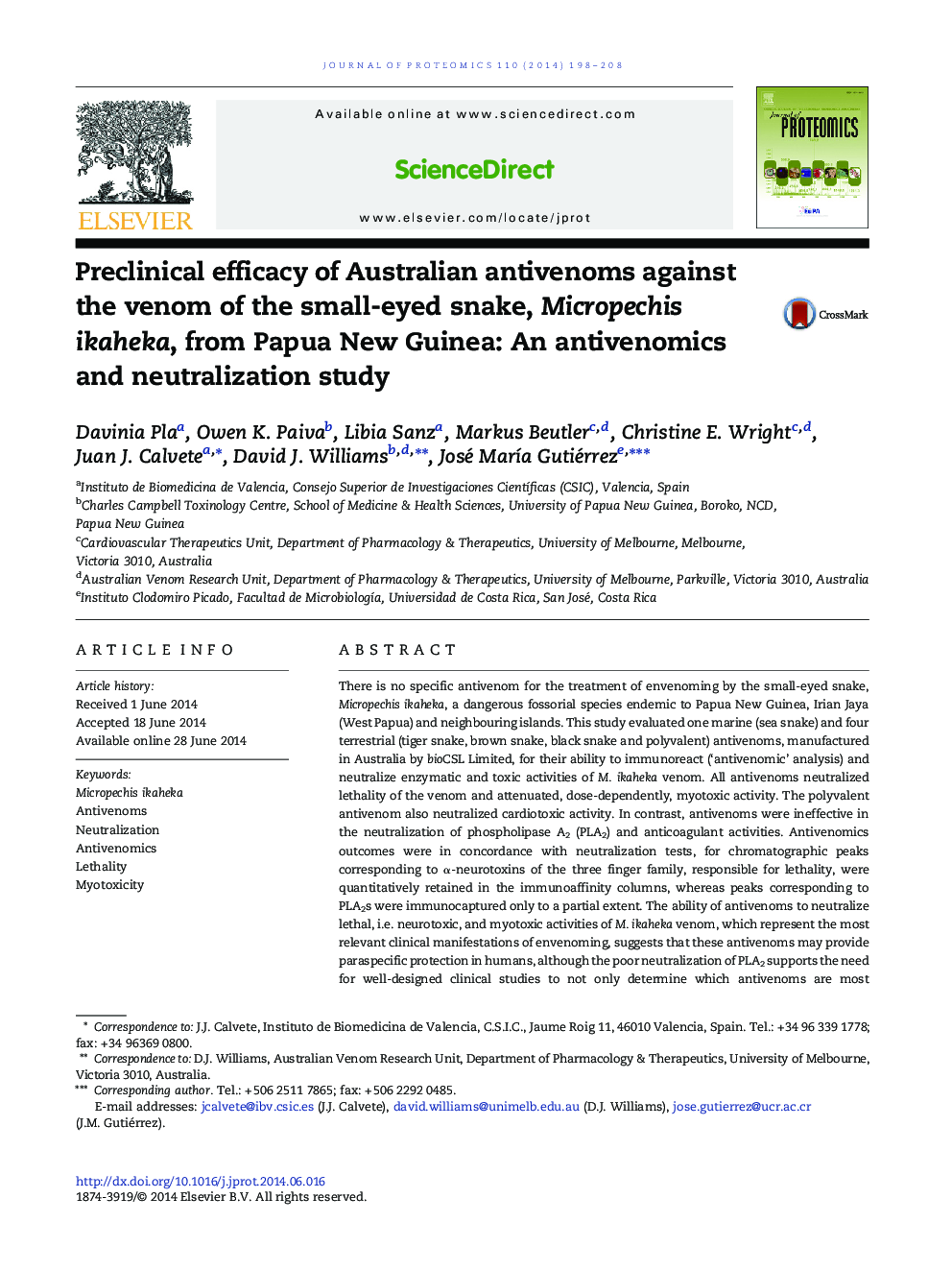| کد مقاله | کد نشریه | سال انتشار | مقاله انگلیسی | نسخه تمام متن |
|---|---|---|---|---|
| 1225731 | 1494770 | 2014 | 11 صفحه PDF | دانلود رایگان |

• Five Australian antivenoms were tested against the venom of Micropechis ikaheka.
• Antivenoms neutralized lethal and myotoxic, but not phospholipase A2, activities.
• By antivenomics, antivenoms had a strong reactivity against α-neurotoxins.
• Antivenoms showed a partial immunoreactivity against phospholipases A2.
• Immunoreactivity against α-neurotoxins explains the neutralization of lethality.
There is no specific antivenom for the treatment of envenoming by the small-eyed snake, Micropechis ikaheka, a dangerous fossorial species endemic to Papua New Guinea, Irian Jaya (West Papua) and neighbouring islands. This study evaluated one marine (sea snake) and four terrestrial (tiger snake, brown snake, black snake and polyvalent) antivenoms, manufactured in Australia by bioCSL Limited, for their ability to immunoreact (‘antivenomic’ analysis) and neutralize enzymatic and toxic activities of M. ikaheka venom. All antivenoms neutralized lethality of the venom and attenuated, dose-dependently, myotoxic activity. The polyvalent antivenom also neutralized cardiotoxic activity. In contrast, antivenoms were ineffective in the neutralization of phospholipase A2 (PLA2) and anticoagulant activities. Antivenomics outcomes were in concordance with neutralization tests, for chromatographic peaks corresponding to α-neurotoxins of the three finger family, responsible for lethality, were quantitatively retained in the immunoaffinity columns, whereas peaks corresponding to PLA2s were immunocaptured only to a partial extent. The ability of antivenoms to neutralize lethal, i.e. neurotoxic, and myotoxic activities of M. ikaheka venom, which represent the most relevant clinical manifestations of envenoming, suggests that these antivenoms may provide paraspecific protection in humans, although the poor neutralization of PLA2 supports the need for well-designed clinical studies to not only determine which antivenoms are most appropriate for treatment of M. ikaheka envenoming, but to also fully describe the syndrome of envenoming caused by this beautiful, but lethal species.Biological significanceSnakebite by the small-eyed snake, Micropechis ikaheka, in Papua New Guinea can be life-threatening. The predominant clinical features in this envenoming are neurotoxicity and systemic myotoxicity. Although it accounts for only a small proportion of snakebites on the mainland, 40% of snakebites on Karkar Island are attributed to bites by the Ikaheka snake. However, no specific antivenom is available for the treatment of M. ikaheka envenoming in Papua New Guinea. This study evaluated a panel of Australian bioCSL antivenoms for their paraspecific immunoreaction and neutralization of the toxic activities of M. ikaheka venom. All antivenoms exhibited strong immunorecognition of α-neurotoxins of the 3FTx family and neutralized the lethal, i.e. neurotoxic, and myotoxic activities of M. ikaheka venom. However, these antivenoms exhibited poor neutralization of PLA2 and anticoagulant activities. This study suggests that the Australian antivenoms may provide paraspecific protection against M. ikaheka venom in humans, a hypothesis that demands studies aimed at assessing whether these antivenoms neutralize neurotoxicity and myotoxicity in the clinical setting.
Figure optionsDownload high-quality image (101 K)Download as PowerPoint slide
Journal: Journal of Proteomics - Volume 110, 14 October 2014, Pages 198–208